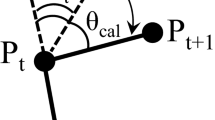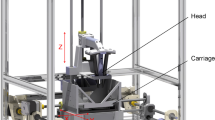Abstract
In this study, we describe the development of a behavioral trajectory measurement system called Bucket-ANTAM to measure the behavior of organisms when moving on a two-dimensional plane. The Bucket-ANTAM system detects the center-of-gravity movement of the target organism through a camera-based image analysis and controls a Dynamixel MX-106 servo motor with an attached omni-wheel to realize the function required to track the organism. We investigated the negative phototaxis of pill bugs (Armadillidium vulgare) using the developed Bucket-ANTAM to evaluate its usefulness. We conducted an experiment in which the pill bugs were reared in a simulated day/night environment using a light source, where the pill bugs were subjected to light stimulation from one direction only. The results of this experiment demonstrated that the pill bugs migrated more quickly under the night-time conditions than under the daytime conditions and that the pill bugs under the night-time conditions were more likely to express negative phototaxis.







Similar content being viewed by others
Change history
02 November 2022
A Correction to this paper has been published: https://doi.org/10.1007/s10015-022-00820-4
References
Abe M, Fujioka H (2017) Quantification and analysis on animal social behavior (in Japanese). J Robot Soc Jpn 35(6):455–458
Censi A, Straw AD, Sayaman RW et al (2013) Discriminating external and internal causes for heading changes in freely flying Drosophila. PLoS Comput Biol 9(2):e1002891
Nagaya N, Fujisawa R (2017) Virtual reality system for measuring insect’s behaviors (in Japanese). J Robot Soc Jpn 35(6):436–439
Fehlmann G, King AJ (2016) Bio-logging. Curr Biol 26(18):R830–R831
Naito Y (2004) New steps in bio-logging science. Mem Natl Inst Polar Res 58:50–57
Zhang D, Shorter KA, Rocho-Levine J et al (2018) Behavior inference from bio-logging sensors: a systematic approach for feature generation, selection and state classification. In: Dynamic systems and control conference, vol 2, p V002T21A005
McKinnon EA, Love OP (2018) Ten years tracking the migrations of small landbirds: lessons learned in the golden age of bio-logging. Auk Ornithol Adv 135(4):834–856
Brown JM, Taylor PD (2015) Adult and hatch-year blackpoll warblers exhibit radically different regional-scale movements during post-fledging dispersal. Biol Let 11(12):20150593
Carrel JS (1972) An improved treading device for tethered insects. Science 175(4027):1279–1279
Sakuma M (2002) Virtual reality experiments on a digital servosphere: guiding male silkworm moths to a virtual odour source. Comput Electron Agric 35(2–3):243–254
Shigaki S, Fukushima S, Kurabayashi D et al (2016) A novel method for full locomotion compensation of an untethered walking insect. Bioinspir Biomim 12(1):012005
Pun P, Brown J, Cobb T et al (2021) Navigation of a freely walking fruit fly in infinite space using a transparent omnidirectional locomotion compensator (TOLC). Sensors 21(5):1651
Nagaya N, Mizumoto N, Abe M et al (2017) Anomalous diffusion on the servosphere: a potential tool for detecting inherent organismal movement patterns. PLoS One 12(6):e0177480
Kramer E (1976) The orientation of walking honeybees in odour fields with small concentration gradients. Physiol Entomol 1(1):27–37
Weber T, Thorson J, Huber F (1981) Auditory behavior of the cricket. J Comp Physiol 141(2):215–232
Baur B, Gosteli M (1986) Between and within population differences in geotactic response in the land snail Arianta arbustorum (L.)(Helicidae). Behaviour 97(1-2):147–160
Higashi M (2015) On the Development of the omni-directional vehicle with omni wheels (in Japanese). J Kinki Polytech Coll 23:55–58
Kawano Y, Otsuki K, Abe M (2020) Evaluation of pillbug phototaxis by using an omnidirectional motion compensation system (in Japanese). Trans Inst Syst Control Inf Eng 33(3):67–76
Drahokoupilová T, Tuf IH (2012) The effect of external marking on the behaviour of the common pill woodlouse Armadillidium vulgare. ZooKeys 176:145–154
Acknowledgements
We thank David MacDonald, MSc, from Edanz (https://jp.edanz.com/ac) for editing a draft of this manuscript.
Author information
Authors and Affiliations
Corresponding author
Additional information
Publisher's Note
Springer Nature remains neutral with regard to jurisdictional claims in published maps and institutional affiliations.
About this article
Cite this article
Shirai, K., Shimamura, K., Koubara, A. et al. Development of a behavioral trajectory measurement system (Bucket-ANTAM) for organisms moving in a two-dimensional plane. Artif Life Robotics 27, 698–705 (2022). https://doi.org/10.1007/s10015-022-00811-5
Received:
Accepted:
Published:
Issue Date:
DOI: https://doi.org/10.1007/s10015-022-00811-5




